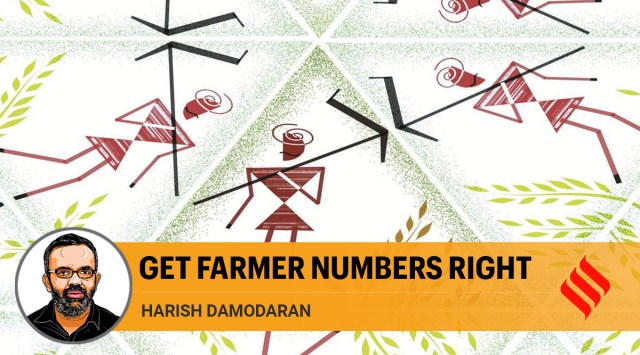- India
- International
Agriculture policy should target India’s actual farming population
Most government welfare schemes are aimed at poverty alleviation and uplifting those at the bottom of the pyramid. But there’s no policy for those in the “middle” and in danger of slipping to the bottom.
 The demand for making MSP a legal right is basically a demand for price parity that gives agricultural commodities sufficient purchasing power with respect to things bought by farmers.(Illustration by C R Sasikumar)
The demand for making MSP a legal right is basically a demand for price parity that gives agricultural commodities sufficient purchasing power with respect to things bought by farmers.(Illustration by C R Sasikumar)How many farmers does India really have? The Agriculture Ministry’s last Input Survey for 2016-17 pegged the total operational holdings at 146.19 million. The NABARD All India Rural Financial Inclusion Survey of the same year estimated the country’s “agricultural households” at 100.7 million. The Pradhan Mantri Kisan Samman Nidhi (PM-Kisan) has around 111.5 million enrolled beneficiaries, with an average of 102 million-plus getting payments during 2020-21.
India’s official farmer population, in other words, is anywhere between 100 million and 150 million. But how much of this comprises actual farmers? Agricultural households, as per NABARD’s definition, cover any household whose value of produce from farming activities is more than Rs 5,000 during a year. That obviously is too little to qualify as living income.
A “real” farmer is someone who would derive a significant part of his/her income from agriculture. This, one can reasonably assume, requires growing at least two crops in a year. The 2016-17 Input Survey report shows that out of the total 157.21 million hectares (mh) of farmland with 146.19 million holdings, only 140 mh was cultivated. And even out of this net sown area, a mere 50.48 mh was cropped two times or more, which includes 40.76 mh of irrigated and 9.72 mh of un-irrigated land. Taking the average holding size of 1.08 hectares for 2016-17, the number of “serious full-time farmers” cultivating a minimum of two crops a year — typically one in the post-monsoon kharif and the other in the winter-spring rabi seasons — would be hardly 47 million. Or, say, 50 million.
The above figure — less than half or even a third of what is usually quoted — is also consistent with other data from the Input Survey. These pertain to the number of cultivators planting certified/high yielding seeds (59.01 million), using own or hired tractors (72.29 million) and electric/diesel engine pumpsets (45.96 million), and availing institutional credit (57.08 million). Whichever metric one considers, the farmer population significantly engaged and dependent on agriculture as a primary source of income is well within 50-75 million.
The current agriculture crisis is largely about these 50-75 million farm households. At the heart of this is the absence of price parity. In 1970-71, when the minimum support price (MSP) of wheat was Rs 76 per quintal, 10 grams of 24-carat gold cost about Rs 185 and the monthly starting pay for a government schoolteacher was roughly Rs 150. Today, the wheat MSP is at Rs 1,975/quintal, gold prices are Rs 45,000/10g and the minimum salary of government schoolteachers is Rs 40,000/month. Thus, if 2-2.5 quintals of wheat could purchase 10g gold and pay a government primary schoolteacher’s salary in 1970-71, the farmer has to now sell 20-23 quintals for the same. Fifty years ago, one kg of wheat could buy one litre of diesel at MSP. Today, that ratio is upwards of 4:1.

The absence of farm price parity didn’t hurt much initially when crop productivity was rising. Pre-Green Revolution, wheat and paddy yields in Punjab averaged 1.2 and 1.5 tonnes per hectare, while trebling to over 3.7 and 4.8 tonnes, respectively, by 1990-91. The output gains reaped by farmers from planting high-yielding varieties more than offset the lower price increases in their produce relative to that of other goods and services.
Since the 1990s, yields have further gone up to 5.1-5.2 tonnes/hectare in wheat and 6.4-6.5 tonnes for paddy. But so have production costs. In cotton, maize, vegetables, milk and poultry products, farmers experienced both yield gains (from Bt and hybrid seeds technology, drip/sprinkler irrigation, laser levelling, crossbreeding and improved agronomic and feeding practices) and favourable prices (on the back of growing domestic incomes and export demand) during the first 15 years or so of this century. The last five-six years, however, have seen prices of these crops come under relentless downward pressure. This, even as costs — whether of diesel, pesticides and, more recently, non-urea fertilisers — have escalated.
The demand for making MSP a legal right is basically a demand for price parity that gives agricultural commodities sufficient purchasing power with respect to things bought by farmers. It is coming mainly from the 50-75 million “serious full-time farmers” who have surplus to sell and with real stakes in agriculture. They are the ones whom “agriculture policy” should target. Most government welfare schemes are aimed at poverty alleviation and uplifting those at the bottom of the pyramid. But there’s no policy for those in the “middle” and in danger of slipping to the bottom.
An annual transfer of Rs 6,000 under PM-Kisan may not be small for the part-time farmer who earns more from non-agricultural activities. It is a pittance, though, for the full-time agriculturist who spends Rs 14,000-15,000 on cultivating just one acre of wheat and, likewise, Rs 24,000-25,000 on paddy, Rs 39,000-40,000 on onion and Rs 75,000-76,000 on sugarcane. When crop prices fail to keep pace with escalating costs — of not only inputs, but everything the farmer buys — the impact is on the 50-75 million surplus producers. They have seen better times, when yields were on the rise and the terms of trade weren’t as much against agriculture.
Any “agriculture policy” has to first and foremost address the problem of price parity. Should this be ensured through MSP-based procurement, paying the difference between MSP and the market price, or simply per-acre transfers? Would farmer interest be even better served by the government guaranteeing a minimum “income” rather than “price” support? These are details that can be worked out once there is clarity on the number of farmers for whom crop prices actually matter.
Subsistence or part-time agriculturalists, on the other hand, would benefit more from welfare schemes and other interventions to boost non-farm employment. Even within farming, the opportunities for them aren’t in regular crop agriculture. A one-acre farmer can rear five cows and sell 30 litres of milk daily from three at any given time. The same small holding can, alternatively, house a broiler farm with up to 10,000 birds and six batches being sold in a year.
Whether it is crop, livestock or poultry, agriculture policy has to focus on “serious full-time farmers”, most of them neither rich nor poor. This rural middle class that was once very confident of its future in agriculture today risks going out of business. That shouldn’t be allowed to happen.
This column first appeared in the print edition on April 19, 2021 under the title ‘Get farmer numbers right’. The writer, national rural affairs and agriculture editor for The Indian Express, is currently on sabbatical with the Centre for Policy Research, Delhi
EXPRESS OPINION
More Explained
Apr 26: Latest News
- 01
- 02
- 03
- 04
- 05










































